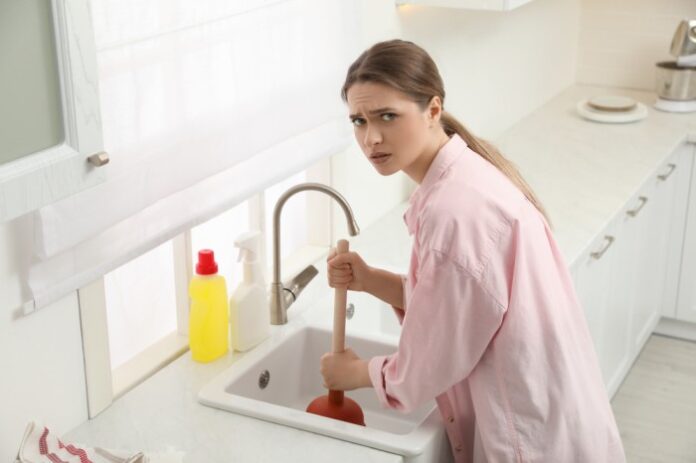Sinks don’t get much attention from homeowners, at least not until the water drains painfully slowly and the basin is about to overflow with dirty water. At some point, the sinks in the kitchen and bathroom will unavoidably get partially or entirely clogged. Most problems originate from the trap, which is the U-shaped pipe beneath the fixture. Although the trap is required to prevent sewage gases from seeping into your home, the pipe’s curved shape may be rather bothersome. Call the plumber later if your home’s water isn’t flowing smoothly. Without expert assistance, most drain obstructions are simple to resolve.
How to Unblock a Sink (Bathroom or Kitchen Sink)
Follow this article to save time and avoid costly mistakes when unclogging a sink.
1. Use hot water to flush a slow-draining kitchen sink
Grease accumulation in drainage pipes is a risk, particularly if the drain is linked to your garbage disposal. When you have a slow-draining kitchen sink, pour a spoonful of dish soap and a pot of boiling water down it. The hot water should break up and dissolve the grease enough to clear the blockage in the sink. In the future, be careful not to put oil or food scraps down the sink drain or into the garbage disposal.
2. Be careful using chemicals
Many people go for chemical drain cleaners when a sink becomes clogged, but these caustic solutions can damage PVC pipes and even ruin older metal pipes. Chemical splashes can burn your skin and eyes. Personal damage is also a possibility. Consider purchasing a biodegradable solution that employs enzymes to dissolve clogs if you wish to use a commercial drain cleaner. These biodegradable substitutes are safer and will protect your pipes even if they don’t operate as rapidly as chemical cleaners.
3. Try using a plunger
With a typical cup plunger, you might be able to remove the obstruction if it is in the drainpipe. Some clogs only require an additional “push” to move! A few inches of water should be in the sink, and the overflow drain should be blocked with a wet cloth to prevent water leaks. Afterward, position the rubber suction over the sink drain in a direct line, and forcefully plunge up and down.
4. Snake the Drain
The distinctive feature of a plumber’s auger sometimes referred to as a drain snake, is a long, coiled wire with a hook or pointed cutter on the end. A manual auger may be purchased at your local hardware store for about $30. Remove the sink strainer before placing the augur’s tip down the pipe and rotating the hand crank to release the wire cable. You know you’ve hit the obstruction when feeding more snakes down the drain meets resistance. Rotate the auger to clear the blockage.
5. Eliminate the trap to remove sticky clogs
The curved drain trap behind the sink is where most sink clogs happen; this pipe typically has the shape of a P, S, or J. The jam might be released most easily by removing the trap. After draining the sink’s extra water, put a bucket beneath the drainpipes since the trap holds water and will release it when undone. Remove the trap by loosening the connections with a twist. By using gloves, you may remove a blockage from here. If you find that the obstruction is deeper down the drainpipe, insert your auger and start digging.
Bottomline
Get in touch with some professionals right away if you have tried all these solutions and still can’t clear your bathroom sink. Your problem will be handled by expert plumbers in a better way.







